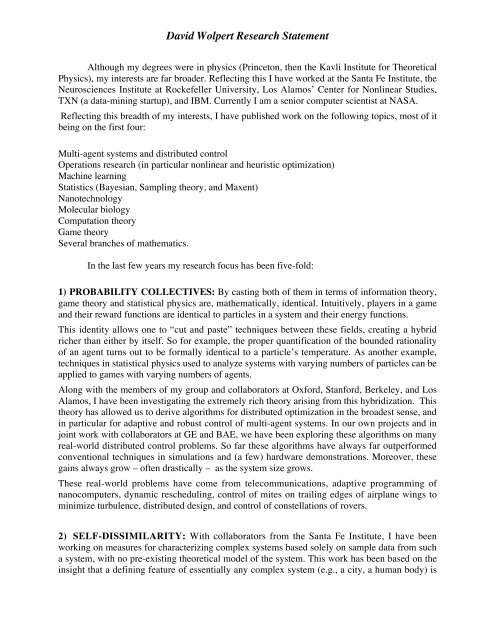David Wolpert Research Statement - NASA
David Wolpert Research Statement - NASA
David Wolpert Research Statement - NASA
You also want an ePaper? Increase the reach of your titles
YUMPU automatically turns print PDFs into web optimized ePapers that Google loves.
<strong>David</strong> <strong>Wolpert</strong> <strong>Research</strong> <strong>Statement</strong>Although my degrees were in physics (Princeton, then the Kavli Institute for TheoreticalPhysics), my interests are far broader. Reflecting this I have worked at the Santa Fe Institute, theNeurosciences Institute at Rockefeller University, Los Alamos’ Center for Nonlinear Studies,TXN (a data-mining startup), and IBM. Currently I am a senior computer scientist at <strong>NASA</strong>.Reflecting this breadth of my interests, I have published work on the following topics, most of itbeing on the first four:Multi-agent systems and distributed controlOperations research (in particular nonlinear and heuristic optimization)Machine learningStatistics (Bayesian, Sampling theory, and Maxent)NanotechnologyMolecular biologyComputation theoryGame theorySeveral branches of mathematics.In the last few years my research focus has been five-fold:1) PROBABILITY COLLECTIVES: By casting both of them in terms of information theory,game theory and statistical physics are, mathematically, identical. Intuitively, players in a gameand their reward functions are identical to particles in a system and their energy functions.This identity allows one to “cut and paste” techniques between these fields, creating a hybridricher than either by itself. So for example, the proper quantification of the bounded rationalityof an agent turns out to be formally identical to a particle’s temperature. As another example,techniques in statistical physics used to analyze systems with varying numbers of particles can beapplied to games with varying numbers of agents.Along with the members of my group and collaborators at Oxford, Stanford, Berkeley, and LosAlamos, I have been investigating the extremely rich theory arising from this hybridization. Thistheory has allowed us to derive algorithms for distributed optimization in the broadest sense, andin particular for adaptive and robust control of multi-agent systems. In our own projects and injoint work with collaborators at GE and BAE, we have been exploring these algorithms on manyreal-world distributed control problems. So far these algorithms have always far outperformedconventional techniques in simulations and (a few) hardware demonstrations. Moreover, thesegains always grow – often drastically – as the system size grows.These real-world problems have come from telecommunications, adaptive programming ofnanocomputers, dynamic rescheduling, control of mites on trailing edges of airplane wings tominimize turbulence, distributed design, and control of constellations of rovers.2) SELF-DISSIMILARITY: With collaborators from the Santa Fe Institute, I have beenworking on measures for characterizing complex systems based solely on sample data from sucha system, with no pre-existing theoretical model of the system. This work has been based on theinsight that a defining feature of essentially any complex system (e.g., a city, a human body) is
that the spatio-temporal patterns exhibited at different scales differ drastically from one another.Conversely, non-complex systems tend to be highly self-similar (e.g., a gas, a crystal, or a gas).This leads to the use of self-dissimilarity measures to analyze complex systems. Intuitively, theself-similarity of a system is akin to the first moment of a distribution – it is all that is notcaptured in such a “first moment” that goes into defining the system’s self-dissimilarity.Such measures can be viewed as quantifications of how different the computation processes atdifferent scales are, and how information flows between the scales. Preliminary experiments withsuch measures have applied them to 1-dimensional bit strings and 2-dimensional visual images.With other colleagues we are now investigating their application to procedures in a hospital’sICU and to financial time series data.3) FUNDAMENTAL PHYSICAL LIMITS ON COMPUTATION: I am engaged in researchon an alternative to the Chomsky hierarchy that is, I would argue, a better reflection ofcomputation (and more generally observation, control, and other kinds of inference) as it actuallyarises in the physical universe.This alternative hierarchy has a very rich mathematical structure, one that imposes a number oflimits on what kind of computation, observation, and control can transpire in the physicaluniverse. These limits do not rely on chaotic processes, limits on the Chomsky power of one’scomputer, etc. In fact they are independent of the precise laws of physics governing our universe.As a result, they provide (for example) an uncertainty principle for observation that holdsindependent of quantum mechanics.4) EXTENDING THE DEFINITION OF A METRIC: I have also recently worked on how toextend the conventional definition of a metric - intuitively, a measure of distance between twopoints - to measure “distance” within sets of more than two points. Amongst other issues, doingthis has required extending the concept of the triangle inequality to involve more than two points.This work promises to provide an algorithm mapping the characteristics of a space to anassociated metric for comparing probability distributions over that space. No longer would oneuse a one-size-fits-all measure to quantify distance between probability distributions. This wouldpotentially have applications throughout machine learning, statistics, and information theory.5) PREDICTIVE GAME THEORY: Traditional noncooperative game theory hypothesizesthat the joint mixed strategy of a game satisfies an “equilibrium concept”, with all other jointstrategies being impossible. As an alternative one can (and arguably must) view the prediction ofthe joint strategy of a game as an exercise in decision theory. This means that one must firstarrive at a probability distribution over possible joint mixed strategies. It is then the loss functionof the external scientist making the prediction that picks which single joint strategy to actuallypredict; for the same game, different loss functions result in different “equilibrium concepts”.Information theory and Bayesian reasoning can be used to arrive at the distribution over jointstrategies. Among other things, the resulting mathematics provides a first-principlesquantification of bounded rationality, one which explicitly arises as a cost of computation. Withcollaborators at Berkeley and Urbana-Champaign, I am using this quantification to measure howrationality changes in experimental human subjects under different conditions. Ultimately, thehope is to integrate this work with AI-style user-modeling, to generate a full-blown formalismfor predicting the behavior of individual humans in economic scenarios.
















